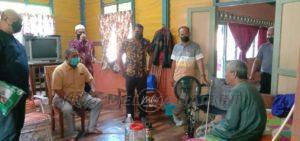
Dusun Nyior and Haji Sulong: The Thai Construct of a Separatist Narrative
The “Haji Sulong Rebellion” was constructed as the master narrative by the Thai state. The arrest of the modernist scholar and intellectual, on 16th January 1948 spelt the beginning of the end of Pattani. Together with his associates, they were charged with treason. On April of the same year, clashes between Malays, and Thai police and military forces began at Dusun Nyior in Rangae district, Narathiwat. The Thai version label the incident as the “Dusong Yo Rebellion.” Led by a religious leader Haji Abdul Rahman, the crowd first attacked the police station.
The clashes with the police lasted two days, involving up to 1,000 men in an open battle. It was said that at least 400 Malay Muslim peasants and 30 policemen were killed. The Dusun Nyior incident was a culmination of many simmering conflicts between Malay Muslims and Thai authorities. There was deep prejudice and fear from both sides. Following the suppression of the clashes, some 2,000 to 6,000 Malays fled to Malaya.
Soon an estimated 250,000 Patani Malays had signed a petition requesting the United Nations to preside over the separation of the four Malay Muslim provinces from Thailand and their incorporation into the newly-formed Federation of Malaya.
In a 2004 paper, published in 2008 titled “Origins of Malay Muslim ‘Separatism’ in Southern Thailand,” (in Michael J. Montesano and Patrick Jory, eds. Thai South and Malay North: Ethnic Interactions on a Plural Peninsula, NUS Press, reprinted in 2020), Thammasat University historian Thanet Aphornsuvan highlights the issue of “facts” in modern Thai political history. According to the “facts”, Malay Muslims are “untrustworthy because they have continually rebelled against and resisted the rule of Siam since the Ayuthaya period and throughout the Rattanakosin, or Bangkok era.” The Malays are also seen to “separate” themselves from Thailand by taking away the provinces of Pattani, Yala and Narathiwat.
Aphornsuvan explains that the national history of Thailand, the predominant historiography since the emergence of modern historical writing in Siam in the late 19th century, maintains that “the Thai Kingdom possessed the Malay states in the South.” The discourse on Thai independence was thus structured around the loss and preservation of its territory. From the Thai perspective, the 1909 Anglo-Siamese Treaty has made Siam ceding “15,000 square miles of territory of its four southern Malay states to imperial Britain.”
Hence the emergence of the conception of a territorially and culturally “Siamese nation-state with fixed borders” – what historian Thongchai Winichakul terms as the “geo-body.” The charge of “separatism” was argued as the logical outcome of the Siamese concept of the nation-state. The Thai narrative “assumed prior existence of the geo-body of Siam,” throwing the idea of the bordered Siamese nation-state “back into the mists of time.” For decades, Malaysia’s social and media environments have been silent on the origins. We are stupefied by labels and semantics. Our consciousness was instead amplified by events – ambush, arson, attacks.
Studies on the conflict and violence have glossed over the origins and conveniently focussed on later much publicized developments. The cost of historical ignorance and amnesia about the origins of separatism in the north/south (depending on which geopolitical perspective) is, according to Aphornsuvan, to prolong and tacitly approve poor studies of modern Thai political history.
Aphornsuvan who had served as Thammasat’s Southeast Asian Studies Program, identifies two perspectives on modern Thai political history. The first comprises mostly foreign scholars and journalists of the 1940s generation critical of Thai government’s policies and its handling of the Malay Muslims. They tended to support the right to self-determination of the Malays. The second group comprising writers and scholars, mainly Thai academics and officials, whose views and temperament are conditioned by their loyalty to the state and sense of Thai nationalism.
The group from foreign observers during the period following the Second World War up to the 1960s more sympathetic to Malay rights to self-determination, had accused the Thai government of prejudice against its Malay Muslim population by its categorization of them as “khaek” or “guests.” This implies that the Malays are “outsiders” or “minorities”, and finally as “separatist bandits” – and this was what we hear over the Malaysian media, especially in the last few decades of the last century. The Thais call them chon baeng yaek dindaen.
Another cycle of violence began on 4 January 2004, the so called “January Fourth Incident,” where an army camp was raided. It was said to have humiliated the Thai government. Then on 28 April 2004 simultaneous pre-dawn raids were conducted on police and military outposts of Yala, Songkhla and Narathiwat. The Thai prime minister responded that those were the work of “drug addicts.”
The historical meaning of the “April 28 killings,” where a total of 112 died in the clashes, was not lost on the public. Immediately after the carnage, Thammasat University peace studies scholar and political scientist, Chaiwat Satha-anan, a Muslim, came out to stress the political significance of the date: the “April 28 Revolt” was referred to by Malays as “perang” or “kebangkitan Dusun Nyior” (The Dusun Nyior War), while the official Thai discourse calls it the “kabot dusong yo” (the Dusong Yo Rebellion).
The Thai version according to Aphornusan, is that the Malay Muslim banded together in meetings and began a terrorist act following Dusun Nyior and the arrest of Haji Sulong in 1948. He was crafted as the sole leader and cause of the “rebellion” in the south as well as the uprising at Dusun Nyior. Mainstream Thai historical writing and narrative have done little to correct this view. Malay newspapers and political parties in Malaya were sympathetic to their kinsmen, hoping for a separation from the Thai state to join Malaya.
In 1954, Haji Sulong mysteriously disappeared after reporting to the police special branch in Songkhla (the Thai name replacing the Malay Singgora). He was believed to have been murdered on the night of 13 August 1954.
#####
Next week:
Hikayat Nakhoda Muda
Langgani saluran Telegram kami untuk dapatkan berita-berita yang terkini.


